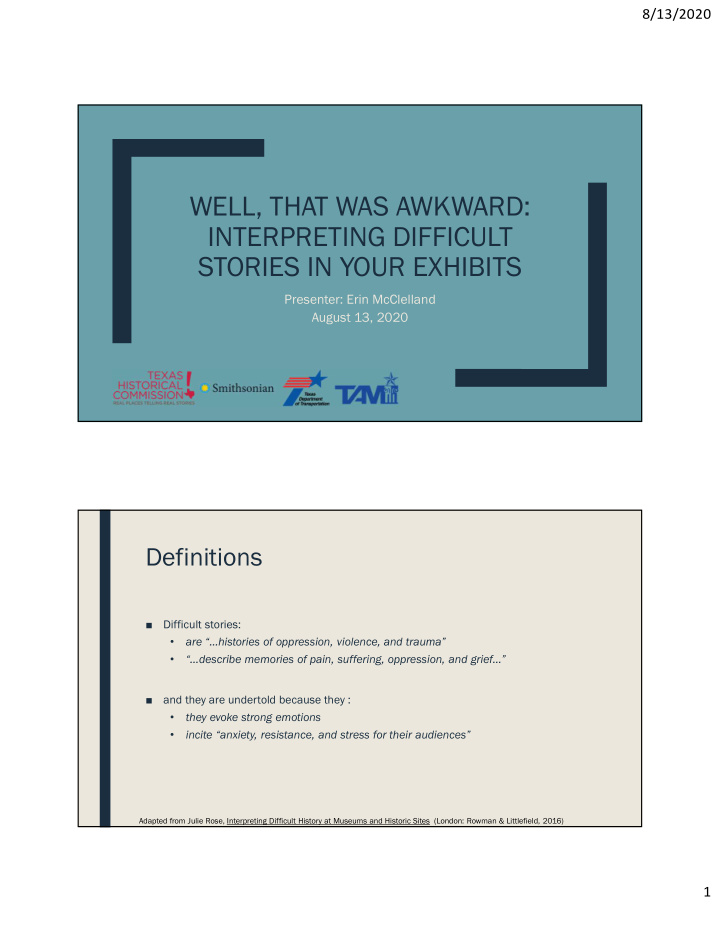



8/13/2020 WELL, THAT WAS AWKWARD: INTERPRETING DIFFICULT STORIES IN YOUR EXHIBITS Presenter: Erin McClelland August 13, 2020 Definitions ■ Difficult stories: • are “…histories of oppression, violence, and trauma” • “…describe memories of pain, suffering, oppression, and grief…” ■ and they are undertold because they : • they evoke strong emotions • incite “anxiety, resistance, and stress for their audiences” Adapted from Julie Rose, Interpreting Difficult History at Museums and Historic Sites (London: Rowman & Littlefield, 2016) 1
8/13/2020 Examples of Difficult and Undertold Stories • Enslavement of African Americans • Climate change • Confederate monuments • Evolution • Discrimination against members of LGBTQ community • Environmental injustice and racism • Disparate access to resources (transportation, economic, educational, natural, etc.) Photo of I-37 construction through Northside community in Corpus Christi. Photo by Corpus Christi Caller-Times, annotated by HNTB . (Courtesy of TxDOT) Why Are These Stories So Difficult? These stories are difficult – evoking strong emotions and creating anxiety, stress, and resistance – because they challenge our core beliefs about the world, society, history, and, by extension, ourselves. That creates a crisis moment where the audience has to decide between two options: 1. Accept the information and be forced to adapt, question everything OR 2. Reject the information and maintain the status quo Adapted from Julie Rose, Interpreting Difficult History at Museums and Historic Sites (London: Rowman & Littlefield, 2016) 2
8/13/2020 Difficult Stories in Action Adapted from The Oatmeal, “You’re not going to believe what I’m about to tell you,” http://theoatmeal.com/comics/believe_clean Difficult Stories in Action Adapted from The Oatmeal, “You’re not going to believe what I’m about to tell you,” http://theoatmeal.com/comics/believe_clean 3
8/13/2020 Difficult Stories in Action Adapted from The Oatmeal, “You’re not going to believe what I’m about to tell you,” http://theoatmeal.com/comics/believe_clean Difficult Stories in Action (in all likelihood) Adapted from The Oatmeal, “You’re not going to believe what I’m about to tell you,” http://theoatmeal.com/comics/believe_clean 4
8/13/2020 Why Are These Stories So Difficult? ■ These stories are difficult – evoking strong emotions and creating anxiety, stress, and resistance – because they challenge our core beliefs about the world, society, history, and, by extension, ourselves. ■ That creates a crisis moment where the audience has to decide between two options: 1. Accept the information and be forced to adapt, question everything OR 2. Reject the information and maintain the status quo Adapted from Julie Rose, Interpreting Difficult History at Museums and Historic Sites (London: Rowman & Littlefield, 2016) Examples of Difficult Stories: The Interstate Highway System ■ “The greatest public works project in history.” ■ “An integral part of the American way of life.” ■ One of President Eishenhower’s top five achievements while in office. (Courtesy of U.S. Department of Transportation, Federal Highway Administration) 5
8/13/2020 Examples of Difficult Stories: The Interstate Highway System East Avenue before the construction of IH-35 (Courtesy of TxDOT) ; IH-35 c. 1970 (Courtesty of Austin History Center) Navigating the Crisis Moment 1. Accept the information and be forced to adapt, question everything OR 2. Reject the information and maintain the status quo 6
8/13/2020 Put a Name (and a Face) on It Remember the UpStairs Lounge by Skylar Fein (Courtesy of New Orleans Museum of Art) Put a Name (and a Face) on It Yav Hashem, The Holocaust History Museum, Hall of Names (Courtesy of Yav Hashem) 7
8/13/2020 Put a Name (and a Face) on It Yav Hashem, The Holocaust History Museum, Hall of Names (Courtesy of Yav Hashem) Put a Name (and a Face) on It Yav Hashem, The Holocaust History Museum, Hall of Names (Courtesy of Yav Hashem) 8
8/13/2020 Signals to Visitors: Transition Spaces National World War I Museum & Memorial (Courtesy of Ralph Applebaum Associates) Signals to Visitors: Transition Spaces National World War I Museum & Memorial (Courtesy of Ralph Applebaum Associates) 9
8/13/2020 Signals to Visitors: Warnings National Museum of African American History and Culture (Courtesy of What to See in Washington DC) Open Floor Plan Images from Kathleen McLean, Planning for People in Museum Exhibitions (Washington, D.C: 1993), 125. 10
8/13/2020 Open Floor Plan Climates of Inequality traveling exhibition by the Humanities Action Lab (Courtesy of Humanities Action Lab) Reflection Spaces Museo de la Memoria y los Derechos Humanos, Santiago, Chile (Courtesy of Nico Saieh) 11
8/13/2020 Reflection Spaces Museo de la Memoria y los Derechos Humanos, Santiago, Chile (Courtesy of Nico Saieh) Reflection Spaces National Museum of African American History and Culture (Courtesy of Brad Feinknopf) 12
8/13/2020 Reflection Spaces “On the Texas Homefront,” Bullock Texas State History Museum Reflection Spaces “On the Texas Homefront,” Bullock Texas State History Museum 13
8/13/2020 Reflection Spaces “The Enclave,” Portland Art Museum Reflection Spaces “The Enclave,” Portland Art Museum 14
8/13/2020 Join us next week for: Made You Look!: How to Select Visuals That Will Keep Visitors Engaged with Your Exhibits Thursday, August 20, 2020, at 10:00 a.m. Find this week’s resource sheet at: https://www.thc.texas.gov/local-exhibits This training was made possible by: 15
Recommend
More recommend